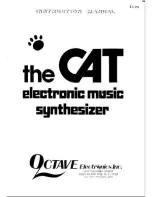
EDIT PROGRAM - SINGLE
S3000XL Operator’s Manual
Page 79
When the
parameter is set to 00, the random steps will only
change when a new note-on is received and will sustain at that level until a
new note-on is received. I.e:
MIDI NOTE ONS
By applying this LFO in this way to, say, FILTER 1, each note you play
may have a different tonal colour and this can be made into quite a
dramatic synth effect by setting quite high modulation amounts and high
resonance. With percussive sounds, this can be a very interesting rhythmic
backing for tightly sequenced arpeggios and riffs and the like. By applying
this to panning, each note will be in a different position in the stereo
image. On single note, you will get a dramatic panning effect as the sound
bounces all over the stereo image and in chords, each note will position
itself in different positions giving the impression of great depth and spread
to the sound.
However, this facility can be also used more subtly! By applying a tiny
amount of the RANDOM waveform to pitch (try a depth setting of 01),
each note may have a very tiny pitch discrepancy. In a layered string or
vocal ensemble, by applying this to just one of the layers, you can create
interesting chorus effects as each note has a slightly different detune
amount.
Similarly, when applied in small amounts, this can also be used effectively
on ‘ethnic’ sounds such as pan pipes as the ‘real thing’ is rarely perfectly in
tune from one note to the next. On a rich analogue synth sound, you can
also emulate the fact that these old synths’ tuning left a lot to be desired!
There are many possibilities which you will no doubt find for yourself.
This sets the rate of LFO1. This is variable between very slow for such
effects as auto panning and filter sweeps and fast for vibrato and other
effects. The default here is slow as it is assumed you will want to use this
LFO for such things as filter sweeps and slow panning effects, etc..
This sets the master output level for LFO2. Unlike LFO1, its default is 99
so you will instantly hear the effect of LFO2’s modulation as soon as you
apply it at any destination.
This sets the delay between a note-on occurring and the effect being
introduced. At 00 the effect will be instantaneous and at 99 the effect will
take some 5 or 6 seconds to be introduced. I.e.
NOTE ON
















































